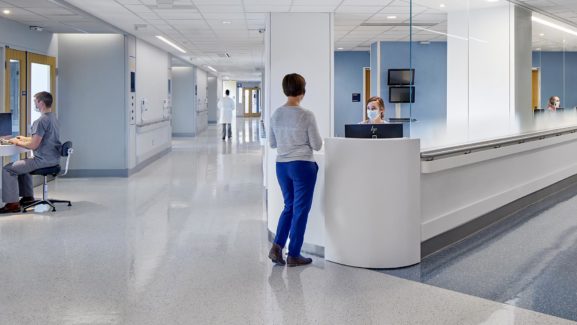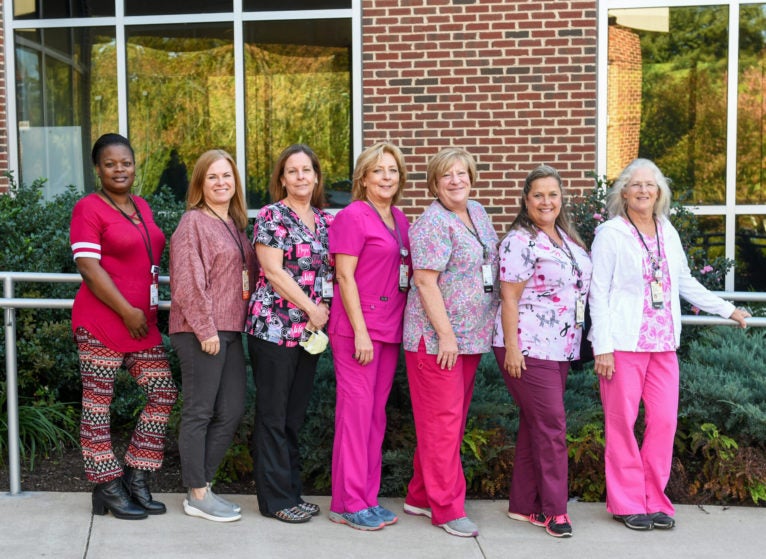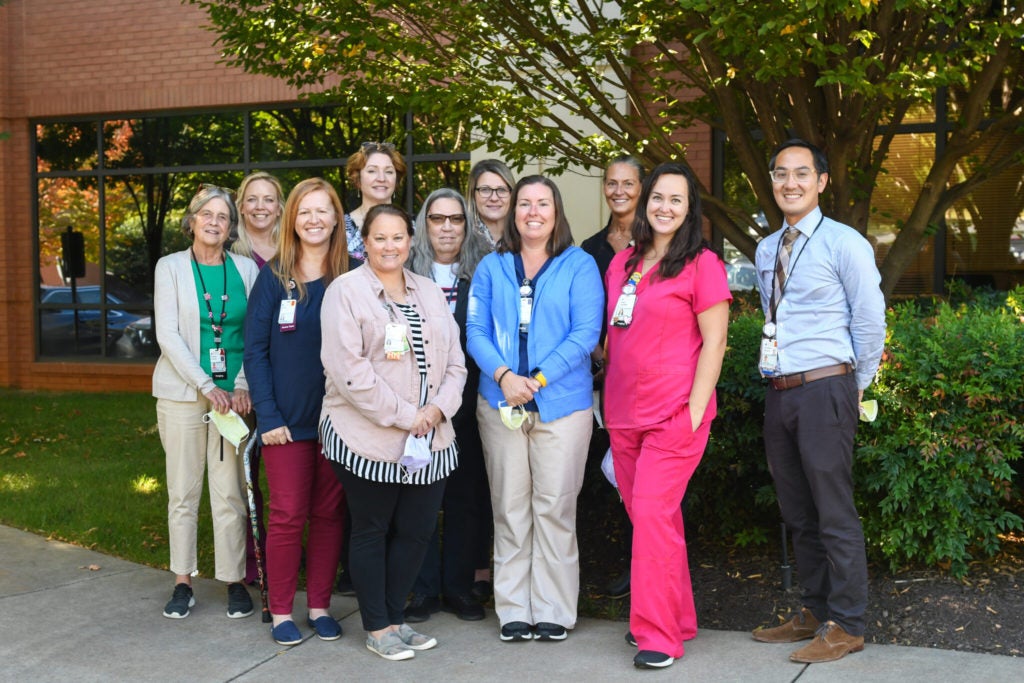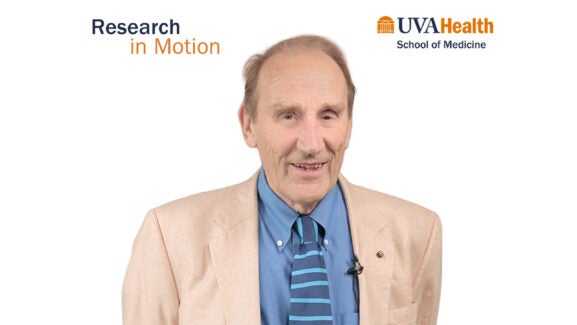

The Northridge Mammography team. Left to right: Melissa Gaines, Kathy Repich, Marie Barnett, S. Lynette Narciso, Edie Swetnam, Deborah Berry and Donna Marshall.
Mammography Techs Comfort, Connect, and Save Lives
October is Breast Cancer Awareness Month, an annual campaign to raise awareness about the impact of breast cancer. To help mark this month, we’re highlighting UVA Radiology’s mammography technologists. This remarkable group guides patients through all aspects of their mammograms — from answering their questions to prepping them for their exam; positioning them in the mammogram machine to taking the actual images.
It’s estimated that one in eight women will have breast cancer during their lifetimes. If that cancer is detected before it spreads outside the breast, the five-year survival rate is over 99%. That’s where mammograms come in: They are the best way to detect breast cancer early. The earlier breast cancer is found, the better the outcome.
Most women will have annual mammograms for at least part of their adult life. Annual screening mammography is offered to all women beginning at age 40 and continuing as long as a woman is in good health. Women at high lifetime risk of breast cancer may start screening at an even earlier age.
Mammography technologists are specially trained to operate mammography scanners and create the images that radiologists use to diagnose breast cancer. But they do so much more than just operate the machine. For most people getting mammograms, a mammography tech is the only person they may interact with before, during, and after their exam.
Many people experience anxiety or apprehension about the results of mammograms or discomfort from the physical exam. Or they might not know why yearly mammograms are important for their health. Patients come to rely on mammography techs for support, comfort, and connection during an uncomfortable and potentially nerve-wracking time.
For techs, that close bond with patients is what makes their job special.
A Uniquely Close Connection
At UVA Health, mammography technologists work in two main locations: the newly opened Breast Care Center on Pantops, and at Mammography Northridge. Mammograms are also performed on the UVA Mobile Mammography coach, which brings breast cancer screenings directly to communities across the state.
Mammography techs are mainly responsible for performing mammograms, but they also perform bone density scans and some ultrasounds. If a patient needs a biopsy, a tech will help prep the patient and assist the doctor during the biopsy, too. “Even if a technologist is not performing a biopsy or an exam themselves, they are doing everything else.” says Rebecca Griswold, Mammography Supervisor at the Breast Care Center. “They have to keep on their toes.”
Mammography techs are with patients the entire time they are at UVA. They bring patients back to their exam room, help them prepare and explain what they should expect during the exam. They perform the actual imaging, and afterwards explain how and when patients will receive their results. They also prepare patients for any additional screenings or exams they may have that day.
“We have a tremendous amount of patient interaction,” Lorie Hubbard, Interim Chief Mammography Tech at the BCC, says. “For screening exams, the tech is actually the only person a patient interacts with. And we are so close to our patients the entire time. I think that’s why I like breast imaging so much.”
They do this over and over again each day. All told, the two main UVA mammography sites perform about 30,000 mammograms a year, or about 120 a day. And that’s with a team of just 14 technologists! That means that each team member performs over 2,000 mammograms annually.

Comforting Patients at an Uncomfortable Time
But the numbers only tell part of the story of the impact that mammography techs have.
Many women dread mammograms because of the compression needed to get good-quality images. Mammography techs are acutely aware of this and do their best to make patients as comfortable as possible.
“It’s not a super comfortable exam, physically,” Lorie says. “The patient is exposed and you have to touch their breasts and compress them, which can hurt.” Compression holds a breast still and reduces the radiation dose needed, so it’s important for both a patient’s health and the quality of the imaging. But it’s not an enjoyable experience.
Listening to and talking with a patient beforehand can help. “We explain that a certain amount of compression is needed to get a diagnostic exam,” says Lorie.”If you explain to a patient that you need it, they often can tolerate it more.”
Rebecca Griswold agrees that explaining what’s happening is helpful for patients. “Most techs talk with patients as an exam is happening. They tell them exactly what is happening as they move into the machine, for example. That explanation is really important: you can change their expectations and make them less apprehensive.”
“Technically speaking, the breast is a pectoralis muscle,” continues Lorie. “So if you physically get a patient to relax, you get a better picture. Then you don’t miss anything. So our job is to literally help a patient feel relaxed.”
Finding Cancers and Saving Lives
Mammography techs don’t all start out in mammography; they might come from diagnostic radiology, or CT. But once they arrive in mammography they tend to stay in their role for the rest of their careers.
Both Rebecca Griswold and Marie Barnett, Supervisor of Northridge Mammography and the Mobile Mammography, emphasize that their teams have had very little turnover, even during the tumultuous COVID period.
Lorie Hubbard, who has been a mammography tech for 31 years, explains why she thinks that is the case: “Mammography is unique. Most of the techs are here because we want to find breast cancer and we want to save lives. It’s a different kind of dedication.”
Donna Marshall, a tech at Northridge who has spent the entirety of her 42-year career at UVA Health, including the last 21 years in mammography, agrees that mammography is a place where techs can make a unique difference:
“A lot of what we do is educating the patient.” Donna says. “Sometimes we might be the only person who does that. Some women come here because their doctors tell them they should, and they know they should, too. But sometimes they don’t realize why it’s so important, or how everyone’s bodies differ, or how family history and age play into the risk.”
“When going over their history and talking about mammograms, it opens up the conversation to all kinds of questions.” she continues. “‘Why are you asking me that?’ or ‘I didn’t know that.’ If nothing else, at least the patient has gotten a better sense of why mammography is important.”
To Donna, Lorie, Rebecca, Marie, and all their colleagues, mammography goes beyond just a job. It becomes a kind of calling, a deeply held belief in imaging’s ability to help people.
Taking Care of Patients and Each Other
Behind the scenes, the mammography teams show their colleagues the same respect, cooperation and kindness that they show patients.
“I’m very blessed to lead a team like this,” says Marie, the supervisor at Northridge. “We’ve been very cohesive as a team, stepping in and filling in. No one has ever said that something is not my job. It’s been a true team effort all around.”
When screening mammograms were paused in summer 2020 because of COVID, mammography techs were relocated to the ED and other areas of the hospital. They were happy to step in and help care for patients.
More recently, the Breast Care Center has stepped in again in the midst of global supply chain troubles.
With breast biopsy supplies in high demand, many hospitals are having trouble acquiring them. In some places, patients are being told they cannot receive their biopsies. But UVA has been able to work with their supplier to acquire sufficient supplies, and has created partnerships with other hospitals to bring patients here to UVA for biopsies. It’s a perfect example of how an attitude of cooperation and a devotion to patient care permeate the entire team. And it shows how attention to detail, behind the scenes, makes patient care better.
Donna Marshall calls the mammography team “a well-oiled machine. Everyone knows their role and everyone does it. That means everything runs very smoothly.”
“Patients see it,” Donna continues. “A lot of times they will tell me ‘I don’t go anywhere else that treats me as well as you do here.’ Appointment times, getting in and out quickly, being treated well: that has something to do with how many of us (techs) have stayed here for so long. And how well we treat each other.”
Latest News




Congrats!! You all do amazing things for women! Great group!